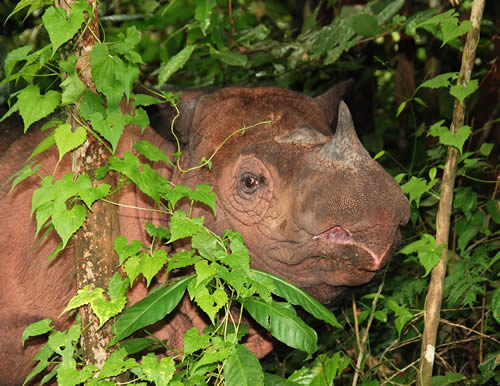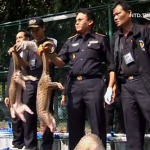
The Sumatran rhino crisis is worse than previously thought. The IUCN has released an updated population estimate of “less than 100 individuals”, essentially halving earlier estimates of 180.
This devastating news was announced at the Sumatran Rhino Summit convened by the International Union for Conservation of Nature’s Species Survival Commission (IUCN SSC), held from March 31st — April 4th, 2013, in Singapore. Fortunately, there is still hope for the Sumatran rhino: According to the IUCN, a “ground-breaking agreement to save the Critically Endangered species was reached between representatives of the Indonesian and Malaysian governments” — marking the first time they have joined together to address the dire situation facing this Critically Endangered species.
More than 130 rhino experts, scientists, government officials and NGO representatives from around the world were in attendance, and a two-year emergency action plan was proposed as an immediate follow-up to the Sumatran Rhino Summit.
“The Sumatran Rhino Crisis Summit has been transformational by bringing together the two governments whose representatives committed to positive and proactive bilateral collaboration which is critical for saving this enigmatic species,” says Mark Stanley Price, Chairman of the IUCN SSC Species Conservation Planning Sub-Committee.
Huge progress has been made in specifying the resources needed to improve rhino surveys, security and monitoring. We have also explored the potential of new technologies and the role of integrating the management of wild and captive individuals.
Widodo Ramano, Executive Director of Yayasan Badak Indonesia (YABI) emphasized that “this could be our last opportunity to save this species “.
We need to act together urgently, hand in hand, replicating some of the inspirational successes of other conservation efforts and aim to stop any failures that might impede progress.
Datuk Dr Laurentius Ambu, Director of the Sabah Wildlife Department, Malaysia, added, “We would like to reiterate Sabah’s commitment and our willingness to further discuss with Indonesia opportunities to exchange reproductive cells of the species, move individual rhinos between our countries and to employ advanced reproductive technology as a parallel initiative in the Sumatran rhino captive breeding programme.”
In 2012, the birth of Andatu to wild-caught mother Ratu and captive-bred father Andalas signaled hope for the future of a successful breeding program for Sumatran rhinos.
Due to the Sumatran rhino’s unfortunate proximity to China — and long before trade in rhino horn was banned — the species was decimated by the use of rhino horn in traditional Chinese medicine. Today, this Critically Endangered species must also contend with the loss of habitat as a result of palm oil production, logging, and human encroachment.
Implementation, political will, and accountability are going to be critical to ensuring that the Sumatran rhino does not suffer the same fate as another Asian rhino species, the Vietnamese Javan rhino (Rhinoceros sondaicus annamiticus), which was confirmed extinct in 2010.


![Pangolin Trafficking: 2011 to August 2013 [Infographic]](https://annamiticus.com/wp-content/uploads/2013/08/PangolinsInTrade2011thruAugust2013-150x150.jpg)
![Pangolin Trafficking: 2011 to April 2013 [Infographic]](https://annamiticus.com/wp-content/uploads/2013/04/PangolinsInTrade2011thru2013-150x150.jpg)
![Indonesia: Pangolin Smugglers Doing Their Dirty Work [Photos]](https://annamiticus.com/wp-content/uploads/2013/10/PangolinsArrive-150x150.jpg)